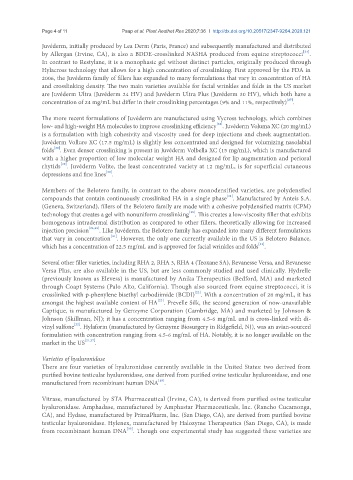Page 394 - Read Online
P. 394
Page 4 of 11 Paap et al. Plast Aesthet Res 2020;7:36 I http://dx.doi.org/10.20517/2347-9264.2020.121
Juvéderm, initially produced by Lea Derm (Paris, France) and subsequently manufactured and distributed
[24]
by Allergan (Irvine, CA), is also a BDDE-crosslinked NASHA produced from equine streptococci .
In contrast to Restylane, it is a monophasic gel without distinct particles, originally produced through
Hylacross technology that allows for a high concentration of crosslinking. First approved by the FDA in
2006, the Juvéderm family of fillers has expanded to many formulations that vary in concentration of HA
and crosslinking density. The two main varieties available for facial wrinkles and folds in the US market
are Juvéderm Ultra (Juvéderm 24 HV) and Juvéderm Ultra Plus (Juvéderm 30 HV), which both have a
[27]
concentration of 24 mg/mL but differ in their crosslinking percentages (9% and 11%, respectively) .
The more recent formulations of Juvéderm are manufactured using Vycross technology, which combines
[24]
low- and high-weight HA molecules to improve crosslinking efficiency . Juvéderm Voluma XC (20 mg/mL)
is a formulation with high cohesivity and viscosity used for deep injections and cheek augmentation.
Juvéderm Vollure XC (17.5 mg/mL) is slightly less concentrated and designed for volumizing nasolabial
[28]
folds . Even denser crosslinking is present in Juvéderm Volbella XC (15 mg/mL), which is manufactured
with a higher proportion of low molecular weight HA and designed for lip augmentation and perioral
[29]
rhytids . Juvéderm Volite, the least concentrated variety at 12 mg/mL, is for superficial cutaneous
[30]
depressions and fine lines .
Members of the Belotero family, in contrast to the above monodensified varieties, are polydensfied
[31]
compounds that contain continuously crosslinked HA in a single phase . Manufactured by Anteis S.A.
(Geneva, Switzerland), fillers of the Belotero family are made with a cohesive polydensified matrix (CPM)
[15]
technology that creates a gel with nonuniform crosslinking . This creates a low-viscosity filler that exhibits
homogenous intradermal distribution as compared to other fillers, theoretically allowing for increased
injection precision [24,32] . Like Juvéderm, the Belotero family has expanded into many different formulations
[31]
that vary in concentration . However, the only one currently available in the US is Belotero Balance,
[31]
which has a concentration of 22.5 mg/mL and is approved for facial wrinkles and folds .
Several other filler varieties, including RHA 2, RHA 3, RHA 4 (Teoxane SA), Revanesse Versa, and Revanesse
Versa Plus, are also available in the US, but are less commonly studied and used clinically. Hydrelle
(previously known as Elevess) is manufactured by Anika Therapeutics (Bedford, MA) and marketed
through Coapt Systems (Palo Alto, California). Though also sourced from equine streptococci, it is
[22]
crosslinked with p-phenylene bisethyl carbodiimide (BCDI) . With a concentration of 28 mg/mL, it has
[22]
amongst the highest available content of HA . Prevelle Silk, the second generation of now-unavailable
Captique, is manufactured by Genzyme Corporation (Cambridge, MA) and marketed by Johnson &
Johnson (Skillman, NJ); it has a concentration ranging from 4.5-6 mg/mL and is cross-linked with di-
[22]
vinyl sulfone . Hylaform (manufactured by Genzyme Biosurgery in Ridgefield, NJ), was an avian-sourced
formulation with concentration ranging from 4.5-6 mg/mL of HA. Notably, it is no longer available on the
market in the US [21,27] .
Varieties of hyaluronidase
There are four varieties of hyaluronidase currently available in the United States: two derived from
purified bovine testicular hyaluronidase, one derived from purified ovine testicular hyaluronidase, and one
[19]
manufactured from recombinant human DNA .
Vitrase, manufactured by STA Pharmaceutical (Irvine, CA), is derived from purified ovine testicular
hyaluronidase. Amphadase, manufactured by Amphastar Pharmaceuticals, Inc. (Rancho Cucamonga,
CA), and Hydase, manufactured by PrimaPharm, Inc. (San Diego, CA), are derived from purified bovine
testicular hyaluronidase. Hylenex, manufactured by Halozyme Therapeutics (San Diego, CA), is made
[33]
from recombinant human DNA . Though one experimental study has suggested these varieties are

